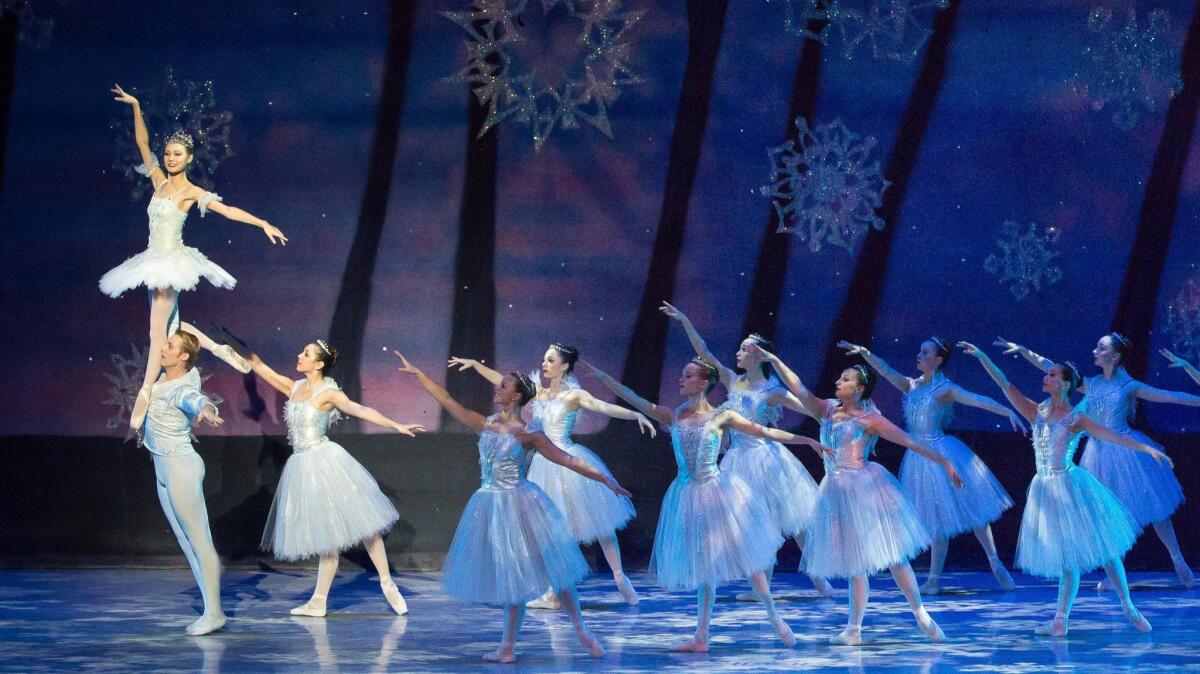Op-Ed: Why we all need a session of ‘Nutcracker’ therapy

It’s that “most wonderful time of the year,” and by that I mean “Nutcracker” season. This holiday the ballet should be more welcome than ever: It’s the perfect antidote to post-election stress and a guide to a more harmonious future.
What, you don’t think “The Nutcracker” fits into American politics? You doubt that a ballet can say something valuable to a populace divided into warring camps and fighting over their existential future?
“The Nutcracker” is not “Hamilton,” but the ballet stage is still the theater, an “unsafe space” on purpose, where questions can be asked and hearts and minds won over, where all manner of values can be danced out.
First, there’s pure, sparkling escapism. If you haven’t seen the ballet, you should know that it plunges you into sweetness and light for a few hours, and that alone ought to be a balm for those feeling bruised and battered by the last year and a half of electoral politics.
There’s also a political subtext. “The Nutcracker” is actually an immigrant that sought refuge and a better life on these shores.
Since “The Nutcracker” became an almost inescapable holiday event in the mid-20th century, it’s been nothing if not an ambassador for polite ballet civility, complete with a rhapsodic Tchaikovsky score that makes you believe in heaven. In it, friends embrace, foreign emissaries dance, children follow orders, and a fond, beautiful couple — the Sugar Plum Fairy and her Prince — shows what spouses who respect each other look like. That might be reason enough to buy a ticket this year.
But there’s also a political subtext. “The Nutcracker” is actually an immigrant that sought refuge and a better life on these shores.
Born in St. Petersburg in 1892, the ballet received mixed reviews. Its friends-of-the-czar audiences found the opening party scene too drab, too ordinary, and Tchaikovsky’s score too complicated for dancing. The full ballet was rarely revived at the Mariinsky Theatre, but it traveled in memory with the Russians who fled after the Revolution. They inspired the first full U.S. “Nutcracker” in San Francisco in 1944.
The czar did not run American dance companies; there was freedom to mount the ballet however a company wanted. And “The Nutcracker,” with its crowded cast and fanciful diversions, was eminently adaptable, a model immigrant; it fit that most American of narratives — e pluribus unum.
In fact, “The Nutcracker” and America started a love affair, especially after 1954, when one of ballet’s most prominent Russian immigrants, George Balanchine, staged his version at the New York City Ballet. “The Nutcracker” then popped up in every major (and most minor) cities across the country. In each venue, it provided a challenge and opportunity for ballet companies of all sorts and sizes, turning into an annual moneymaker that subsidized the art form.
The ballet is grounded in holiday dreams and family warmth. It starts at a lively gathering of friends and family, where the young Clara receives a carved, nut-cracking toy that her rude younger brother promptly breaks. Repairs are made, and when the party is long over, Clara comes downstairs again to sleep by her toy, dreaming the nutcracker comes to life. A disturbing battle between mice and soldiers ensues, and after Clara helps her nutcracker hero win, they journey though waltzing snowflakes to a utopian Candy Land where fantastic characters perform for them.
In the Old World, the opening party scene with excitable children seemed artistically slight, and the second-act dances too unrelated. But in the U.S., that flock of ballet children at the party gave every company a way to attract parents, grandparents and friends to the theater. And the second act fantasy scenes were a lot like a theme park — just something to enjoy in bits. In both acts, Americans found they could make the ballet reflect their own communities, slotting in salsa in one version, Scottish dancing in another, hula in Hawaii, cowboys in Arizona.
In a nation intent on prizing diversity and honoring freedom of religion, that adaptability and the secular nature of “The Nutcracker” appeal to a lot of audiences. There are a Christmas tree and gift-giving at the party, but conviviality and the dancing are what matters, not religion.
“The Nutcracker” also became the first ballet in which people of color were cast regularly. Artistic directors undoubtedly thought anyone could be a dancing flower or bon bon, or pretend to be from Spain. Turns out they can. And if stereotypes inadvertently appear in the Chinese or Arabian dances, there’s always next year to do better.
This season, “The Nutcracker” carries an extra political message. It’s a greedy brat of a boy who breaks Clara’s toy nutcracker at the party. And he and his friends terrorize the girls before peace is restored. The upheaval returns in Clara’s dream battle, but eventually the good guys win, thanks to the astute strategy of a strong woman, which is Clara’s role as she dances through the ballet’s adventures.
That’s not exactly what happened at the polls in 2016, but let ballet put right what the real world gets wrong. The “Nutcracker” message is always hopeful. Good will triumphs. What’s broken can be fixed. Night terrors can be conquered, and snowflakes, fairies, humans and flowers can all communicate harmoniously in the language of dance. The trick is just finding the right steps to take.
Jennifer Fisher is associate professor of dance at UC Irvine and the author of “Nutcracker Nation.”
Follow the Opinion section on Twitter @latimesopinion and Facebook
More to Read
A cure for the common opinion
Get thought-provoking perspectives with our weekly newsletter.
You may occasionally receive promotional content from the Los Angeles Times.










